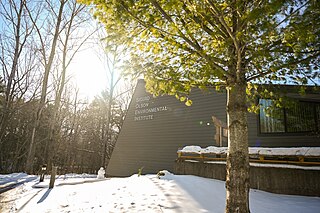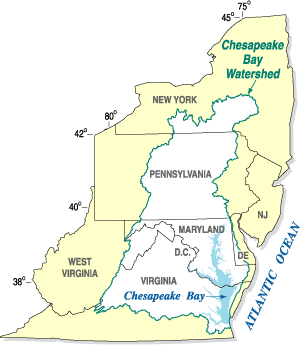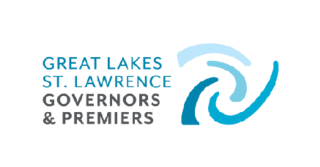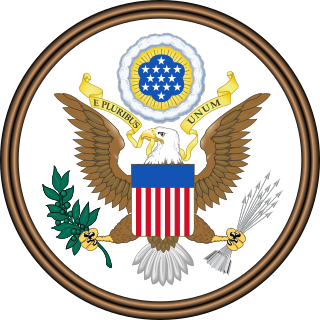The Lake Champlain Basin Program (LCBP) is a program to restore and protect Lake Champlain and its surrounding watershed or drainage basin for future generations. The LCBP works in partnership with government agencies from New York, Vermont, and Quebec, private organizations, local communities, and individuals to coordinate and fund efforts which benefit the Lake Champlain Basin's water quality, fisheries, wetlands, wildlife, recreation, and cultural resources.
These efforts are guided by the 1996 lake management plan "Opportunities for Action: An Evolving Plan for the Lake Champlain Basin." In 2003, the plan was updated and signed by the governors of Vermont and New York, the regional administrators of the United States Environmental Protection Agency, and the prime minister of Quebec. The plan can be read in English and French on the LCBP website. The LCBP is currently working with its partners to implement this plan. Most funding for the LCBP is through the US Environmental Protection Agency. The plan is renowned as an interstate and international model for environmental cooperation.
A local grant program run by the LCBP supports lake-related projects by local communities and non-profit organizations. As of 2007, more than $3 million was targeted to projects in Vermont and New York. Funded projects cover all actions in the plan, from phosphorus reduction, to preventing the spread of nuisance species, to public education and outreach, to restoring important cultural heritage sites.
The top priorities of the management plan are:
Other projects include supporting a lake-wide monitoring program, funding scientific research about the lake, and creating an environmental indicators program to access the progress of lake management actions. Public outreach is supported through school programs, and the LCBP Resource Room at the ECHO, Leahy Center for Lake Champlain on the Burlington, Vermont Waterfront. The LCBP is taking a lead role in coordinating the bi-state commemoration of the 400th anniversary of Samuel de Champlain’s 1609 exploration of the Lake.

Lake Champlain is a natural freshwater lake in North America. It mostly lies between the U.S. states of New York and Vermont, but also extends north into the Canadian province of Quebec.

Stormwater, also written storm water, is water that originates from precipitation (storm), including heavy rain and meltwater from hail and snow. Stormwater can soak into the soil (infiltrate) and become groundwater, be stored on depressed land surface in ponds and puddles, evaporate back into the atmosphere, or contribute to surface runoff. Most runoff is conveyed directly as surface water to nearby streams, rivers or other large water bodies without treatment.

The Sigurd Olson Environmental Institute is an outreach arm of Northland College in Ashland, Wisconsin. The institute originated in 1971 at an environmental conference at Northland that hosted Sigurd Olson as a speaker. Robert Matteson was the founder of the institute. The Institute opened in Spring, 1972.

The Chesapeake Bay Program is the regional partnership that directs and conducts the restoration of the Chesapeake Bay in the United States. As a partnership, the Chesapeake Bay Program brings together members of various state, federal, academic and local watershed organizations to build and adopt policies that support Chesapeake Bay restoration. By combining the resources and unique strengths of each individual organization, the Chesapeake Bay Program is able to follow a unified plan for restoration. The program office is located in Annapolis, Maryland.

The Michigan Department of Natural Resources (DNR) is the agency of the state of Michigan founded in 1921, charged with maintaining natural resources such as state parks, state forests, and recreation areas. It is governed by a director appointed by the Governor and accepted by the Natural Resources Commission. Since 2023, the Director is Scott Bowen. The DNR has about 1,400 permanent employees, and over 1,600 seasonal employees.

The Florida Department of Environmental Protection (FDEP) is the Florida government agency responsible for environmental protection.
The Joint Ocean Commission Initiative is a bipartisan, collaborative group in the United States that aims to "accelerate the pace of change that results in meaningful ocean policy reform." The Joint Initiative was established by the members of two major U.S.-based oceans commissions: the Pew Oceans Commission and the United States Commission on Ocean Policy. It was originally co-chaired by former White House Chief of Staff Leon Panetta and former Chief of Naval Operations Admiral James D. Watkins, chairs of the Pew and U.S. Ocean Commissions, respectively. Currently, the Joint Initiative is led by a Leadership Council, which is co-chaired by Christine Todd Whitman, former EPA Administrator under President George W. Bush and former governor of New Jersey, and Norman Y. Mineta, Secretary of Commerce under President Bill Clinton and Secretary of Transportation under President George W. Bush.
The Water Resources Development Act of 1996 is part of Pub. L. 104–303 (text)(PDF), was enacted by Congress of the United States on October 12, 1996. Most of the provisions of WRDA 1996 are administered by the United States Army Corps of Engineers.

The Nile Basin Initiative (NBI) is a partnership among the Nile riparian states that “seeks to develop the river in a cooperative manner, share substantial socioeconomic benefits, and promote regional peace and security”. The NBI began with a dialogue among the riparian states that resulted in a shared vision objective “to achieve sustainable socioeconomic development through the equitable utilization of, and benefit from, the common Nile Basin water resources." It was formally launched in February 1999 by the water ministers of nine countries that share the river: Egypt, Sudan, Ethiopia, Uganda, Kenya, Tanzania, Burundi, Rwanda, the Democratic Republic of Congo (DRC), as well as Eritrea as an observer. From its beginning the Nile Basin Initiative has been supported by the World Bank and by other external partners. The World Bank has a mandate to support the work of the NBI, as lead development partner and as administrator of the multi-donor Nile Basin Trust Fund. One of the partners is the "Nile Basin Discourse", which describes itself as "a civil society network of organisations seeking to achieve positive influence over the development of projects and programmes under the Nile Basin Initiative".

An ongoing effort to remedy damage inflicted during the 20th century on the Everglades, a region of tropical wetlands in southern Florida, is the most expensive and comprehensive environmental repair attempt in history. The degradation of the Everglades became an issue in the United States in the early 1970s after a proposal to construct an airport in the Big Cypress Swamp. Studies indicated the airport would have destroyed the ecosystem in South Florida and Everglades National Park. After decades of destructive practices, both state and federal agencies are looking for ways to balance the needs of the natural environment in South Florida with urban and agricultural centers that have recently and rapidly grown in and near the Everglades.
The Water Resources Development Act of 1992, Pub. L. 102–580, was enacted by Congress of the United States on October 31, 1992. Most of the provisions of WRDA 1992 are administered by the United States Army Corps of Engineers.
The Water Resources Development Act of 1999, Pub. L. 106–53 (text)(PDF), was enacted by Congress of the United States on August 17, 1999. Most of the provisions of WRDA 1999 are administered by the United States Army Corps of Engineers.
The Water Resources Development Act of 2000, Pub. L. 106–541 (text)(PDF), was enacted by Congress of the United States on December 11, 2000. Most of the provisions of WRDA 2000 are administered by the United States Army Corps of Engineers.

The Susquehanna River Basin Commission (SRBC) is a federal-interstate compact commission created by the Susquehanna River Basin Compact (Pub. L. 91-575) between three U.S. states: (Pennsylvania, New York, and Maryland), and the federal government, and signed into law by President Richard Nixon on Christmas Eve 1970 to be effective 30 days later on January 23, 1971.

Wetland conservation is aimed at protecting and preserving areas of land including marshes, swamps, bogs, and fens that are covered by water seasonally or permanently due to a variety of threats from both natural and anthropogenic hazards. Some examples of these hazards include habitat loss, pollution, and invasive species. Wetland vary widely in their salinity levels, climate zones, and surrounding geography and play a crucial role in maintaining biodiversity, ecosystem services, and support human communities. Wetlands cover at least six percent of the Earth and have become a focal issue for conservation due to the ecosystem services they provide. More than three billion people, around half the world's population, obtain their basic water needs from inland freshwater wetlands. They provide essential habitats for fish and various wildlife species, playing a vital role in purifying polluted waters and mitigating the damaging effects of floods and storms. Furthermore, they offer a diverse range of recreational activities, including fishing, hunting, photography, and wildlife observation.

The Conference of Great Lakes and St. Lawrence Governors and Premiers (GSGP) is a North American intergovernmental organization led by the governing chief executives of the Canadian provinces of Ontario and Québec and the US states of Illinois, Indiana, Michigan, Minnesota, New York, Ohio, Pennsylvania, and Wisconsin. Through the organization, they seek to grow the region's economy and protect the Great Lakes. The organization began in 1983 as the Council of Great Lakes Governors to encourage and facilitate environmentally responsible economic development. The Council now serves as secretariat to the governors’ Compact Council and the governor and premiers’ Regional Body.

Conservation programs for the Mississippi River watershed have been designed to protect and preserve it by implementing practices that decrease the harmful effects of development on habitats and to overlook monitoring that helps future planning and management. A main focus is nutrient pollution from agricultural runoff of the nation's soybean, corn and food animal production, and problems relating to sediment and toxins. Conservation programs work with local farmers and producers to decrease excess nutrients because they cause major water quality problems along with hypoxia and loss of habitat. Organizations such as the Mississippi River/Gulf of Mexico Watershed Nutrient Task Force and USDA programs such as the Upper Mississippi River Forestry Partnership and the Mississippi River Basin Healthy Watersheds Initiative contribute to conserving what is left of the Mississippi River watershed.

Organisms targeted by NISA are categorized as aquatic nuisance species, including in particular zebra mussels and Eurasian ruffe. To extend upon NANPCA, NISA authorizes regulation of ballast water, a key factor in the spread of aquatic invasive species; funding for prevention and control research; regional involvement with the Aquatic Nuisance Species Task Force; and education and technical assistance programs to promote compliance with the new regulations. NISA also includes specific actions for certain geographical locations, such as the Great Lakes, Chesapeake Bay, the Gulf of Mexico, and San Francisco Bay.

Illinois-Indiana Sea Grant provides education, research, and funding to help strengthen and preserve the ecosystems and communities of the southern Lake Michigan region, 104 miles of heavily urbanized and industrialized shoreline in Illinois and Indiana. One third of the population of the Great Lakes lives along the shore of Lake Michigan between Milwaukee, Wisconsin and Michigan City, Indiana, and Lake Michigan is the "largest drinking water supply in the state, serving nearly 6.6 million people ." Illinois-Indiana Sea Grant focuses their efforts in four key areas: Healthy Ecosystems; Sustainable Coasts; Safe, Sustainable Seafood; and Great Lakes Literacy and Workforce Development. Program administration for this organization moved to Purdue University in 2018.
The Namao is a ship ported in Gimli, Manitoba, Canada, whose purpose is to conduct research on Lake Winnipeg. It was originally built for the Canadian Coast Guard (CCG) but was eventually sold to the Lake Winnipeg Research Consortium (LWRC) who converted it to a Lake Winnipeg research vessel. Scientists using the Namao to research the environmental issues concerning the lake, for example the increasing eutrophication of the lake and the impact of invasive species. Using the Namao, the LWRC integrates education and community outreach into their work to promote sustainable living and development focussed on the youth in local communities surrounding Lake Winnipeg who are affected most by the changing dynamics of the lake.